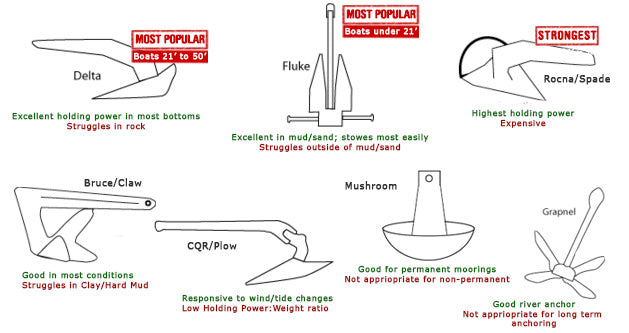
Best for all types of bottoms sand rock mudclay grass. Designed for boats sailboats personal watercraft inflatable boats canoes and float tubes.

Fits under most boat seats in PWC storage compartments or in PWC storage canisters.
Boat anchor for sand bottom. 3 13 pound 4 fluke folding anchor will hold in mud sand gravel and rock. Designed for boats sailboats personal watercraft inflatable boats canoes and float tubes. Fits under most boat seats in PWC storage compartments or in PWC storage canisters.
25 foot long marine grade rope. I would agree that the FX-7 is a great anchor for a sandy or mud bottom. But forget it in most rocky bottoms.
It simply wont grab. Over my boating lifetime Ive had more trouble with fluke anchors like the FX-7 than most other types. Tha Mantus is the current hot choice of many boaters.
Using the pythagorean therom if you are in 20 ft of water and you have 50 ft of anchor rope out your boat will be 4583 feet away from where your anchor is positioned on the bottom. This should be plenty of rope to allow the anchor to lay flat and drag until it grabs ahold and sticks in the sand. Non Hinged Plough Delta Anchor.
Works best in sand rock clay and mud. Non Hinged Plough Roll bar anchor. Best for all types of bottoms sand rock mudclay grass.
Best for sand rock mud. The Roll Bar Plough type anchor is a new type of anchor and therefore is not that common yet. The group of anchors were chosen as being commonly available 35-45 lb.
Anchors suitable for cruising boats in the 35-50 range. Yachting published the results of the first part of the testing in our July 1990 issue documenting the sandy bottom tests held in Florida. Most boating experts agree that for greatest anchoring security you should carry two anchors of different styles one each of the Danforth style and the plowscoop variety.
The type of bottommud grass sand or rockwill dictate different choices of anchors as will the size and windage of the boat the wind conditions and the sea state. FREE Shipping by Amazon. SandShark Lite 18 Sand Anchor Tested Proven to Hold Watercraft Secure Auger to The Beach or Sandbar for Jet Ski PWC Pontoon Kayak Canoe Stainless Steel 18 in wPadded Case No Bungee Line 44 out of 5 stars.
Anchor for sand bottom of lake. You didnt mention what kind of boat you have or what size. In any case get the proper size anchor for your boat.
I use a danforth on a 27ft sail boat on sandy bottom and it works great. Remember to use a 7 to 1 scope. 7 feet of line for every foot deep if windy or fast current.
And haveing 5 or 6 feet. A fluke style anchor is the most common and effective way to secure a boat in sandy bottom. Fortress Anchors are famous for their high-quality build and strong and light aluminummagnesium alloy.
Anchor your boat accordingly. Assess the bottom conditions. Consider the bottom conditions anytime you drop your anchor.
While you may be destined for a soft sandy beach the bottom conditions may not match this description. Bottom conditions can greatly vary at different locations along the beach. Take the bottom conditions into consideration.
Anchor will secure the boat without drifting it away in the waters. Even small boats such as kayaks paddleboats dinghies etc are required to carry a small anchor for safety purposes. Anchors are essential for a boat regardless of the boat type or size.
If the weather changes then the boat can drift easily in the water. Due to their relatively high holding power to weight ratio the Danforth or Fluke anchors are the best for flats boats especially when fishing over sandy or muddy bottom. Particularly the Fortress FX-7 and the 12 lb SeaClaw are the most popular and recommended anchors for flats boats.
We were surprised the Bruce. The type of bottom plays a major role when anchoring because it has a significant influence on the hold of the anchor. Clearly the anchor can easily dig itself into sand or clay rather than on a rocky seabed.
These two types of bottom sand and clay are therefore among the best grounds for anchoring. Care is needed in seagrass. The most popular type of anchors is still considered a fluke anchor as this is an optimal variant for smaller boats.
The key peculiarity of the fluke anchor is its light weight. It stows flat and holds a boat well enough if the bottom is sand or mud. Besides it will stay in place even if the weather is windy.